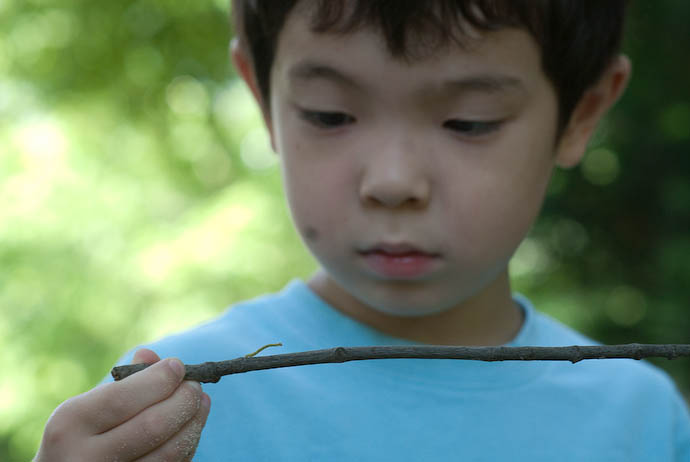
Nikon D200 + Nikkor 85mm f/1.4 — 1/80 sec, f/5, ISO 500 — map & image data — nearby photos
Big Hunkin' Black Splotch
on Anthony's Cheek
Here's an effective way to ruin almost all your shots for the day, before you even start: neglect to notice a big hunk of grunge on your sensor, thereby causing a big black splotch on most of your photos.
As part of the rigorous testing I do for my readership, I embarked on a thorough test of this technique, while on vacation no less, one of the first days I was at my folks' place in Ohio this summer. It was a wonderful summer day, and a walk around outside had great potential for lots of ruined shots, and I was not disappointed.
Er, I was disappointed. I mean, well, you know what I mean.
Here's the same photo, of Anthony checking out an inchworm on a stick, both in its original form, and after I made an attempt to fix it in Lightroom. By mousing over the “original” and “fixed” buttons underneath, the view switches...
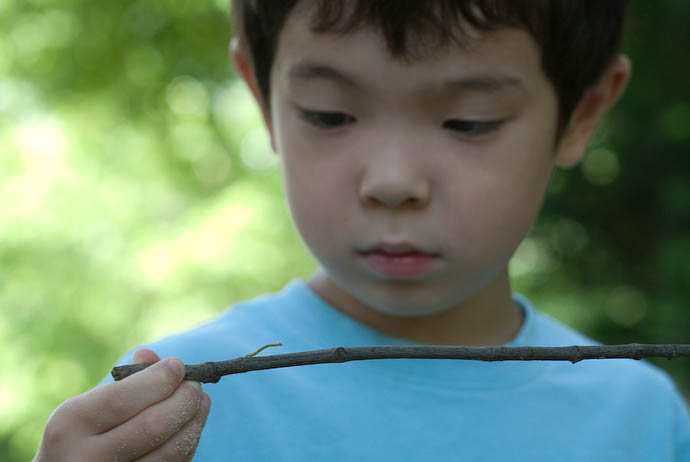
Nikon D200 + Nikkor 85mm f/1.4 — 1/80 sec, f/5, ISO 500 — map & image data — nearby photos
Checking out an Inchworm
The big black splotch on his cheek is readily apparent, but by toggling back and forth, you'll also find a couple of other grungy spots to the upper-right of his nose that I fixed. They were also caused by dust on my lens. I also “fixed” a spot directly above the big one, closer to his eye, but now that I think about it, I think that may be a freckle.
I didn't notice the spot until the evening when I first checked the images on my laptop. I was not happy. A really simple test photo while sitting in the livingroom with my laptop showed the monster gunk on my sensor...
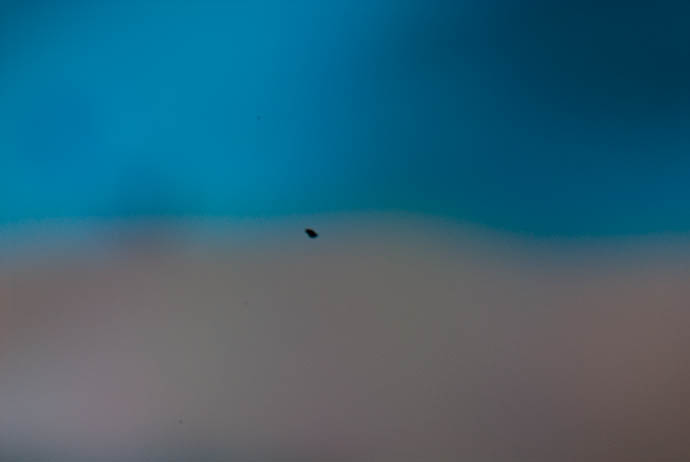
Nikon D200 + Nikkor 85mm f/1.4 — 1/5 sec, f/16, ISO 640 — map & image data — nearby photos
Monster Gunk
Ignore the colors – I hadn't used my sensor-dust reference page – but it's impossible to ignore the huge splotch. Whatever is on there is huge, orders of magnitude beyond “dust”. I calculate that it's 0.49mm long. I doubt that a meadow vole crawling into the mirror box would create as big a shadow. It's huge.
And it shows up on every picture.
I normally use this popular wet method for cleaning my camera sensor, but that stuff was at home in Kyoto, so I took a chance with a can of compressed air and blew the sensor clean. (Warning: there are a lot of ways you can ruin your sensor by trying to clean it with a can of compressed air; don't try it until you understand the risks and how to mitigate them.)
I was able to get it remarkably clean in short order, but that didn't help the 100+ photos from earlier in the day.
Here's one of Anthony's cousin Josh reaching for a dandelion. Mouseover the “original” button to see the heinous splotch...
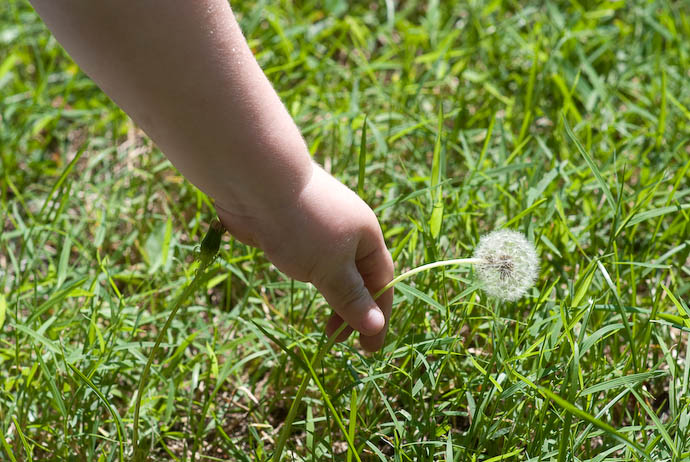
Nikon D200 + Nikkor 85mm f/1.4 — 1/350 sec, f/6.3, ISO 320 — map & image data — nearby photos
Final Moments
The splotch here looks more well defined than the one on Anthony's cheek, because this was taken at a smaller aperture (f/6.3 vs. f/5), and as I describe on my sensor-dust reference page, dust shows up more apparently with smaller apertures. (That's why the gunk-test shot shown above was taken at the very tiny f/16).
The dandelion picture was easy to fix because the splotch fell on an area of uniformity. It's more apparent (and was more difficult to fix) in the next shot of Josh...
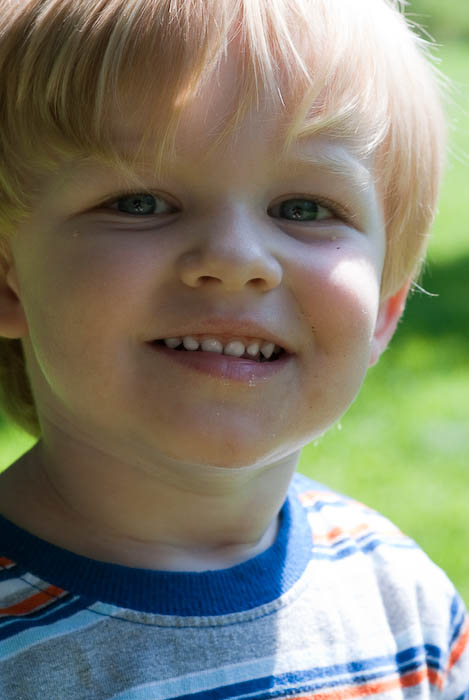
Nikon D200 + Nikkor 85mm f/1.4 — 1/250 sec, f/6.3, ISO 320 — map & image data — nearby photos
Josh Kreta
Not all shots are ruined out of hand; if the splotch ends up in a cluttered part of the composition, you might not even notice it. The rest of the photos in this post have not been corrected....
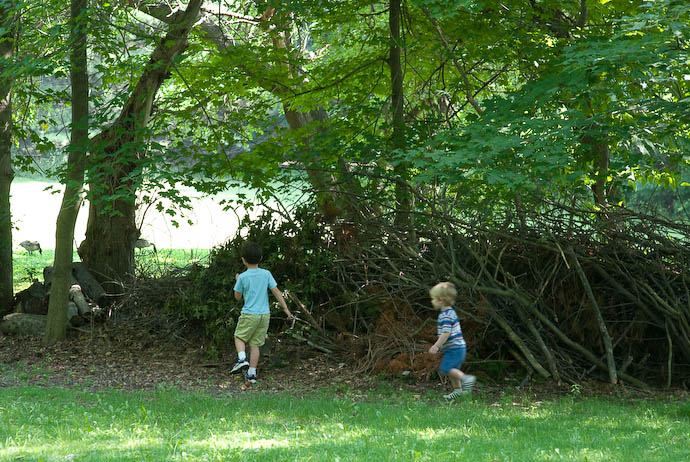
Nikon D200 + Nikkor 85mm f/1.4 — 1/60 sec, f/5, ISO 500 — map & image data — nearby photos
Stalking Geese
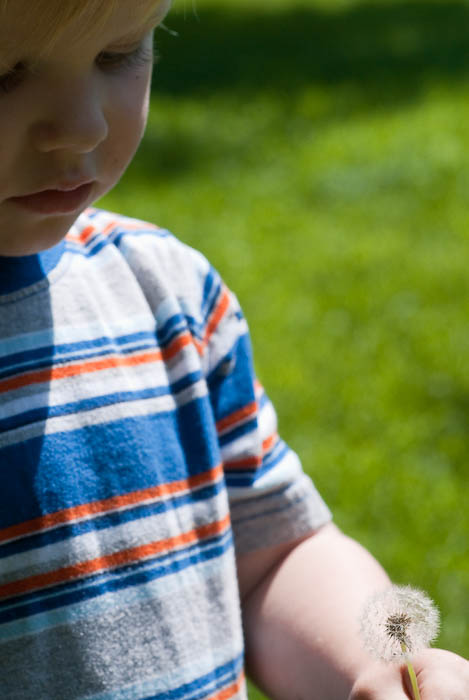
Nikon D200 + Nikkor 85mm f/1.4 — 1/500 sec, f/6.3, ISO 320 — map & image data — nearby photos
Contemplating Fate
( Where “contemplating” is defined as “preparing to”, and “fate” is defined as “obliterate” )
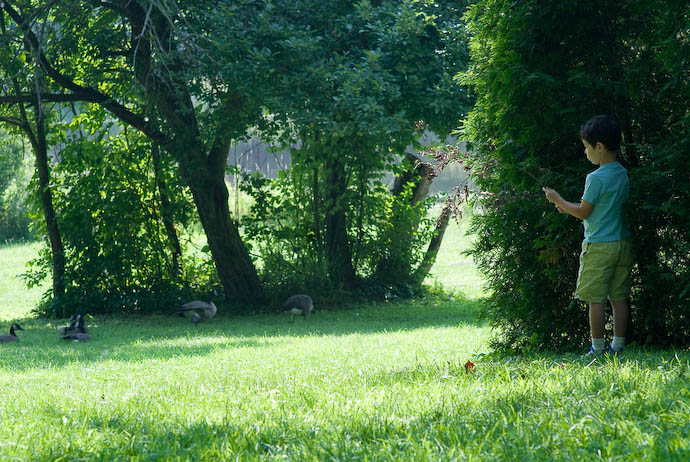
Nikon D200 + Nikkor 85mm f/1.4 — 1/320 sec, f/6.3, ISO 320 — map & image data — nearby photos
Ninja Geese Stalker
he was pretending that the stick is some kind of sidewise periscope
(as if ninja had such devices, silly boy)
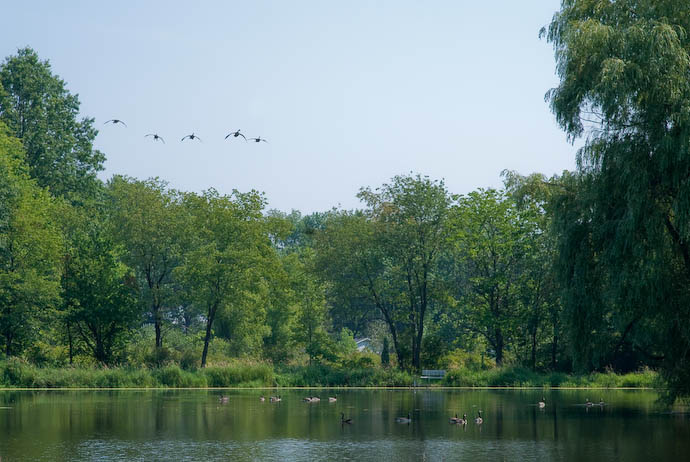
Nikon D200 + Nikkor 85mm f/1.4 — 1/320 sec, f/8, ISO 250 — map & image data — nearby photos
On Final Approach
( I left the big splotch there, lost in the clutter of the trees, but fixed some smaller ones in the sky )
I posed one other goose picture from the summer, that was better than this.
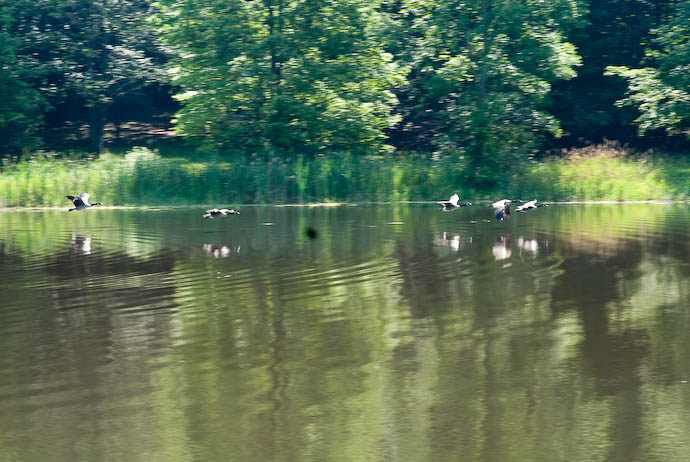
Nikon D200 + Nikkor 85mm f/1.4 — 1/90 sec, f/8, ISO 250 — map & image data — nearby photos
Low Flyover
(okay you can see it clearly there, but it could just be a black hole opening up in the time/lake continuum)
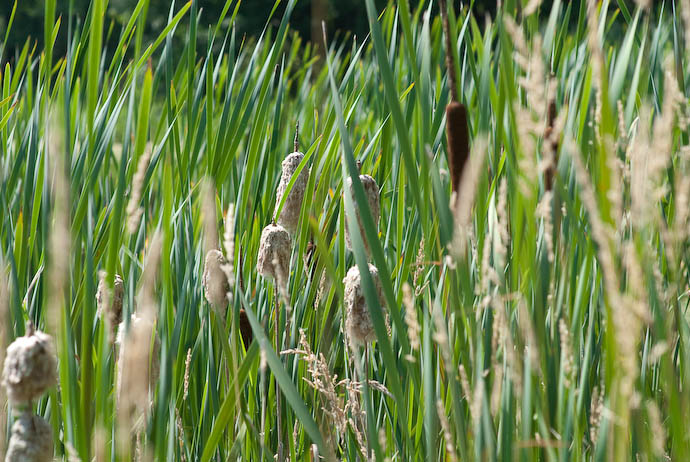
Nikon D200 + Nikkor 85mm f/1.4 — 1/640 sec, f/4.5, ISO 250 — map & image data — nearby photos
Cattails
I like the cattails around the lake, and have posted about them in the past.
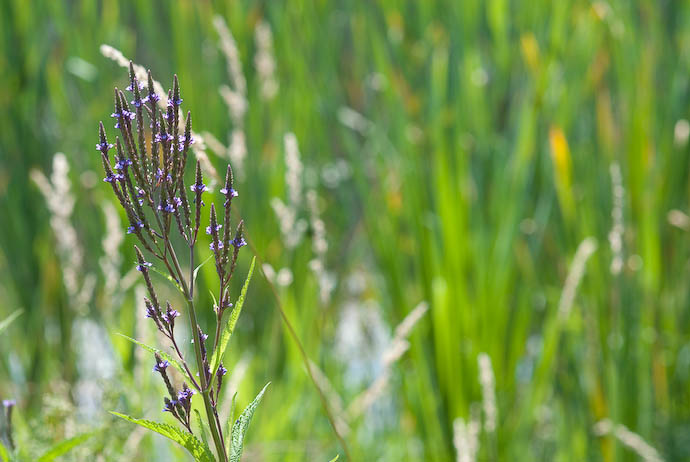
Nikon D200 + Nikkor 85mm f/1.4 — 1/180 sec, f/6.3, ISO 250 — map & image data — nearby photos
Purple... uh... Plant
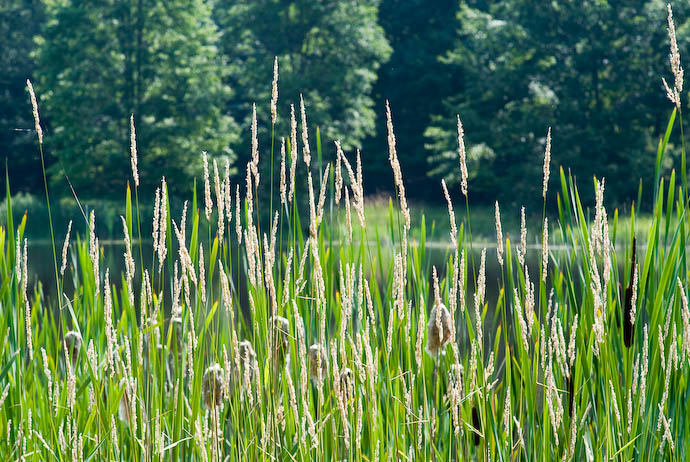
Nikon D200 + Nikkor 85mm f/1.4 — 1/125 sec, f/8, ISO 250 — map & image data — nearby photos
Tall Grass
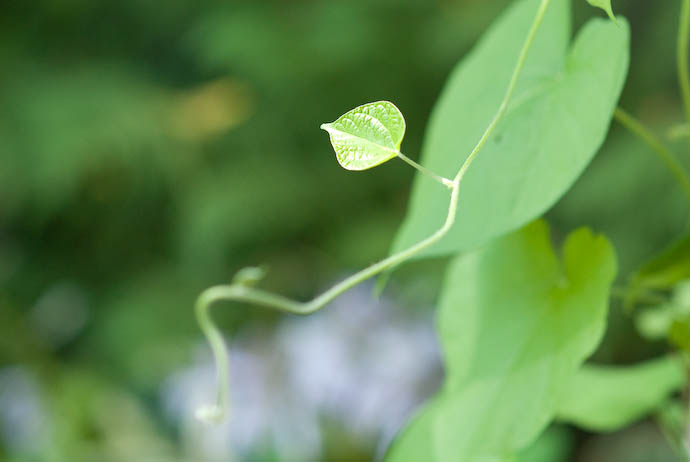
Nikon D200 + Nikkor 85mm f/1.4 — 1/250 sec, f/2.8, ISO 640 — map & image data — nearby photos
Delicate
The big black splotch isn't very apparent in this last image both due to its location, and to its aperture (f/2.8), but the smoothness of the big leaf allows a different splotch to show up clearly. You might not have noticed it, but it's something that almost any serious digital photographer would see (and cringe at) right away. Ugh.
A good pro photographer (e.g. wedding, sports, event, etc...) has a list of things to prepare/check before heading out on a shoot, such as “format memory cards”, “ensure batteries are charged”, and “reset all camera settings”. I'm not a pro and I have no such list, but I've seen them. I've never seen “check for sensor dust” on one, but I think it should be there.
(Unless you're shooting film, of course :-)).
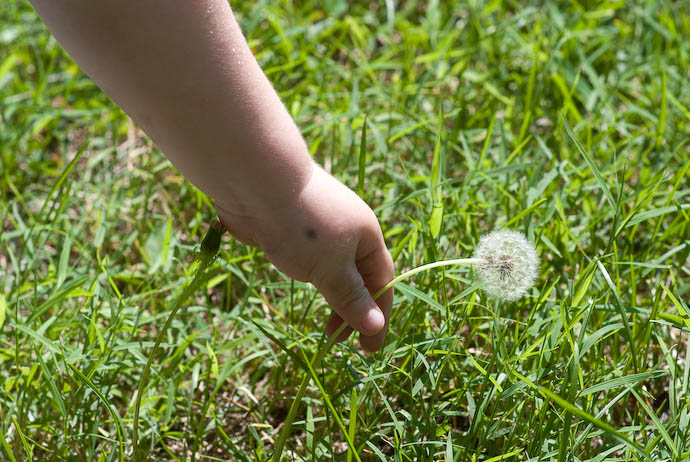
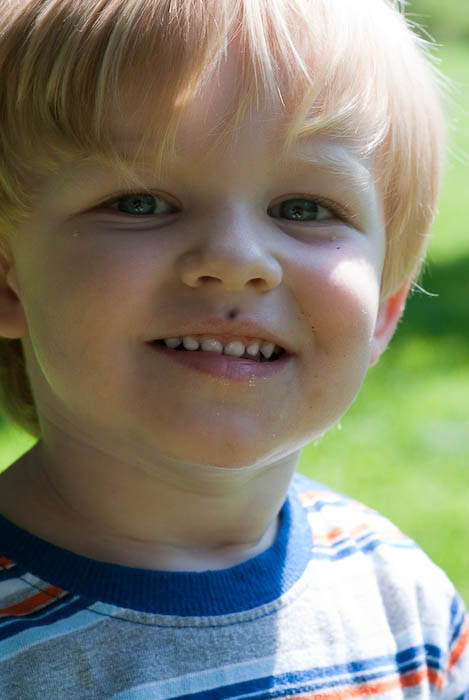
Michael Clark of http://www.michaelclarkphoto.com has taking a dust reference picture as part of his pre-shoot checklist.
Btw, your flickr plugin is great!
Wow … I think you may have just posted one of the more effective arguments yet in the Nikon vs Canon wars. My (original) 1Ds doesn’t have sensor cleaning and I encounter this problem constantly. On the other hand, I have not yet seen a single dust spot in ten months of active shooting with my 40D. I can assure you that my careful avoidance of dusty environments is not a factor. 😉
You can guess how much I use the 1Ds now…
I must say I was rather shocked that the first Google hit on “Nikon D200 sensor cleaning” contained the word “punted.” Why put up with this?
Hi Eric.
(For those of you who don’t know, Eric is the primary developer on the part of Adobe Lightroom that allows plugins like those I write)
I’m not sure I follow your argument. It sounds like you’re saying that your Canon with automatic sensor cleaning is better than your Canon without sensor cleaning, and that makes a lot of sense, but what does that have to do with the “Canon vs. Nikon” wars?
I assume that those who have been shooting with their Nikons (or Sonys or whatnot) that have sensor cleaning also find it better than their Nikons (or Sonys or whatnot) that don’t, so your argument here has thrown me…. —Jeffrey
Re: “It sounds like you’re saying that your Canon with automatic sensor cleaning is better than your Canon without sensor cleaning, and that makes a lot of sense, but what does that have to do with the “Canon vs. Nikon” wars?” Yes, that’s exactly what I’m saying. (Which is surprising given the rather large gap in price between the two.)
For me, now that I have sensor cleaning on a camera, I won’t buy (or even enjoy using) a camera without it. It’s almost like buying a car without a steering wheel.
My initial comment on the N vs C wars was a reaction to finding out that the D200 did not have sensor cleaning and my surprise that Nikon would have ceded that competitive territory. That said, I went back and did a little more research and found that the D200 is not a current body, so auto-cleaning might not have been an essentially required feature back in 2005 when it was introduced.
As far as I can tell, the first Canon with a self-cleaning sensor was the 400D, announced a year after Nikon’s D200. (Canon’s 5D, announced two days before the 400D, didn’t have it). Self-cleaning sensor units have been standard on Nikon stuff since the D3/D300 announced last summer, and my new D700 has it. I’m sure I’ll appreciate the self-cleaning sensor, but it’s not that big a deal to me, because dust wasn’t that big a problem to me. The monster glob on my lens in this post resulted in the first real problems I’ve had with dust, and was perhaps sufficiently big that automatic cleaning wouldn’t have taken care of it had I had it anyway. Dunno. —Jeffrey
I don’t personally have a sensor-cleaning camera (Nikon D70S), so I don’t know how it feels to have one. However, do realize that sensor-cleaning is just one aspect of the dreaded dust monster. Dust on the surfaces of the lens can also add to this and no sensor-cleaning camera can stop that one! 🙂
Even with a sensor-cleaning camera body, you still have to watch out, as it can still leave larger bits of grunge. I found this out on a recent trip… a big nasty splotch showed up in most shots, but its location moved all around as the day progressed. Ugh. Dust on the lens won’t have any effect on this at all, but it can greatly increase flair and lower overall contrast. —Jeffrey